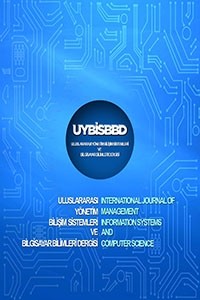Çok Adımlı İşlemlerde Arayüz Kullanılabilirliğinin A/B Test Yöntemiyle İncelenmesi
insan-bilgisayar etkileşimi, sihirbaz, kullanılabilirlik, a/b testi
Examination of Interface Usability in Multi-Step Processes with A/B Testing Method
human-computer interaction, usability, wizard, a/b test,
___
- Ansaar, M. Z., Hussain, J., Abass, A., Hussain, M. ve Lee, S. (2019). “User’s Emotional eXperience Analysis of Wizard Form Pattern Using Objective and Subjective Measures”, (Ed.) Bakaev M., Frasincar F. ve Ko I.-Y., Web Engineering (C. 11496, ss. 521-524), Springer International Publishing, Cham.
- Barnum, C. M. (2011). Usability testing essentials: Ready, set– test. Morgan Kaufmann Publishers. Burlington.
- Budak, V. Ö., Erol, Ç. S. ve Gezer, M. (2017). “Kurumsal Bir Mobil Web Sitesinin Kullanılabilirliğinin Geliştirilmesi”. Ejovoc (Electronic Journal of Vocational Colleges), 7(3), 15-26.
- Budiu, R. (2017). Wizards: Definition and Design Recommendations. Nielsen Norman Group. https://www.nngroup.com/articles/wizards/.
- Carrillo, A. L. ve Falgueras, J. A. (2019). “GDI as an Alternative Guiding Interaction Style for Occasional Users”, (Ed.) Lamas D., Loizides F., Nacke L., Petrie H., Winckler M. ve Zaphiris P., Human-Computer Interaction – INTERACT 2019 (C. 11749, ss. 75-96), Springer International Publishing, Cham.
- Cooper, A., Reimann, R. ve Cronin, D. (2007). About face 3: The essentials of interaction design. Wiley. Indianapolis.
- Courage, C., Baxter, K. ve Caine, K. (2015). Understanding your users: a practical guide to user research methods. Elsevier, Morgan Kaufmann.
- Çağıltay, K. (2011). İnsan bilgisayar etkileşimi ve kullanılabilirlik mühendisliği: Teoriden pratiğe. ODTÜ Geliştirme Vakfı. Ankara.
- Çeti̇n, İ. ve Şendurur, E. (2021). “Online Academic Resources With The Focus Of Eye Behaviors”. Acta Infologica, 5(1), 13-26.
- Dix, A., Finlay, J., Abowd, G. D. ve Beale, R. (2004). Human-computer interaction. Pearson/Prentice-Hall. Harlow.
- Emre, İ. E., Akadal, E. ve Gülseçen, S. (2018). “Örgün ve Uzaktan Eğitim Öğrencileri İçin Kullanılabilirlik Araştırması: Marmara Üniversitesi Web Sitesi”. Uluslararası Yönetim Bilişim Sistemleri ve Bilgisayar Bilimleri Dergisi, 2(1), 12-22.
- Galitz, W. O. (2007). The essential guide to user interface design: An introduction to GUI design principles and techniques. Wiley. Indianapolis.
- Hutchful, D., Matur, A., Cutrell, E. ve Joshi, A. (2010). Cloze: An Authoring Tool for Teachers with Low Computer Proficiency. Proceedings of the 4th ACM/IEEE International Conference on Information and Communication Technologies and Development - ICTD ’10 (ss. 1-10). ACM.
- Hwang, T. K. P., Wu, S.-M., Ding, G.-J., Ko, T.-H. ve Huang, Y.-C. (2017). “Employing Personalized Shortcut Options and Group Recommending Options for Improving the Usability of User Interface of Hospital Self-service Registration Kiosks”, (Ed.) Antona M. ve Stephanidis C., Universal Access in Human–Computer Interaction. Design and Development Approaches and Methods (C. 10277, ss. 357-368), Springer International Publishing, Cham.
- İnal, Y., Özen Çınar, N. ve Çağıltay, K. (2016). “Kamu İnternet Sitelerinde Yer Alan Arama Alanlarının Kullanılabilirliği ve Buna Yönelik Kullanıcı Davranışlarının Belirlenmesi”. Bilişim Teknolojileri Dergisi, 9(1), 41-54.
- ISO. (1998). ISO 9241-11:1998(en), Ergonomic requirements for office work with visual display terminals (VDTs)—Part 11: Guidance on usability. https://www.iso.org/obp/ui/#iso:std:iso:9241:-11:ed-1:v1:en.
- Kılıç, E. ve Güngör, Z. (2006). “Kütüphane Web Sitelerinin Kullanılabilirliği: Bir Uygulama Çalışması”. Journal of the Faculty of Engineering and Architecture of Gazi University, 21(4), 781-789.
- Koester, H., Simpson, R. ve Mankowski, J. (2013). “Software wizards to adjust keyboard and mouse settings for people with physical impairments”. The Journal of Spinal Cord Medicine, 36(4), 300-312.
- Kuniavsky, M., Goodman, E. ve Moed, A. (2012). Observing the user experience: A practitioner’s guide to user research. Morgan Kaufmann. Amsterdam.
- Lazar, J., Feng, J. H. ve Hochheiser, H. (2017). Research methods in human-computer interaction. Morgan Kaufmann. Cambridge.
- Lombardi, J.-P. ve Vogel, J. (2010). Wizard-Based Process Modeling for Business Users. Proceedings of the International Conference on Advanced Visual Interfaces - AVI ’10 (ss. 406). ACM.
- Menghi, R., Gullà, F. ve Germani, M. (2018). “Assessment of a Smart Kitchen to Help People with Alzheimer’s Disease”, (Ed.) Mokhtari M., Abdulrazak B. ve Aloulou H., Smart Homes and Health Telematics, Designing a Better Future: Urban Assisted Living (C. 10898, ss. 304-309), Springer International Publishing, Cham.
- Nielsen, J. (1993). Usability engineering. Morgan Kaufmann. Amsterdam Heidelberg.
- Nielsen, J. (2005). Putting A/B Testing in Its Place. Nielsen Norman Group. https://www.nngroup.com/articles/putting-ab-testing-in-its-place/.
- Nielsen, J. (2012). A/B Testing, Usability Engineering, Radical Innovation:What Pays Best? Nielsen Norman Group. https://www.nngroup.com/articles/ab-testing-usability-engineering/.
- Paulino, D., Pinheiro, P., Rocha, J., Martins, P., Rocha, T., Barroso, J. ve Paredes, H. (2020). Assessment of wizards for eliciting users’ accessibility preferences. 9th International Conference on Software Development and Technologies for Enhancing Accessibility and Fighting Info-exclusion (ss. 135-140). ACM.
- Rosenzweig, E. (2015). Successful user experience: Strategies and roadmaps. Morgan Kaufmann Publisher. Massachusetts
- Rubin, J. ve Chisnell, D. (2008). Handbook of usability testing: How to plan, design, and conduct effective tests. Wiley. Indianapolis.
- Sengpiel, M. (2016). “Teach or Design? How Older Adults’ Use of Ticket Vending Machines Could Be More Effective”. ACM Transactions on Accessible Computing 9(1), 1-27.
- Shneiderman, B. ve Plaisant, C. (2004). Designing the user interface: Strategies for effective human-computer interaction. Pearson/Addison Wesley. Boston.
- Tseytlin, E., Linkov, F., Castine, M., Legowski, E. ve Jacobson, R. S. (2018). “DomainBuilder: The Knowledge Authoring System for SlideTutor Intelligent Tutoring System”. F1000Research 2018, 7:1721.
- Zhang, L., Yang, X., Cota, Z., Cui, H., Ford, B., Chen, H., Macklin, J. A., Reznicek, A. ve Starr, J. (2021). “Which methods are the most effective in enabling novice users to participate in ontology creation? A usability study”. Database, 2021, 1-23
- Başlangıç: 2017
- Yayıncı: Adem KORKMAZ
İnsansız Hava Araçları Tabanlı Çevresel Uygulamalara Genel Bir Bakış
Şenol ERGUNŞAH, Selahattin KOŞUNALP
Çok Adımlı İşlemlerde Arayüz Kullanılabilirliğinin A/B Test Yöntemiyle İncelenmesi
Ömer Faruk ASLANDOĞDU, Hakan AYDIN, Ali ÇETİNKAYA
Kripto Para Birimlerinin Twitter Verileri ile Metin Madenciliği Kapsamında İncelenmesi
Nur Kuban TORUN, Abdülkadir ŞENGÜL
Elektrikli Araçlar İçin Doğrulama ve Faturalama Şeması: EVABS
Kişisel Beslenme Planlamasina Yönelik Web Tabanli Uzman Sistem Tasarimi ve Uygulamasi
